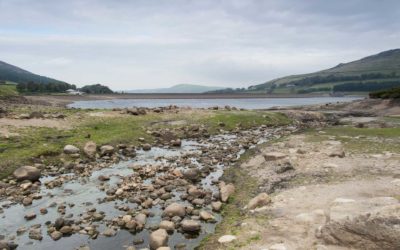Place Based Planning aims to provide a holistic and integrated approach to planning for sustainable water services, which puts communities and the places where people live and work at the centre of the approach. It ensures we consider and involve communities in the solution and supports preventative, cost effective responses by building resilient communities and targeting investment based on what works locally. It seeks to enable new development whilst ensuring it is done in a sustainable way, with a particular focus on making space for water at the outset.
The drivers behind Place Based Planning are:
1. Climate change mitigation/adaption and nature recovery cannot be done in organisational silos;
2. A lack of integrated planning in a geography, which is acting as a key barrier to identifying catchment and nature based solutions;
3. The need to engage potential partners at the outset to maximise the chances of co-funded schemes;
4. The opportunity to deliver multiple benefits.
Three strategic catchments have been chosen within United Utilities to develop the place based planning approach. These catchments are the Upper Mersey, Eden and Wyre. Continue reading, to view the interactive map below detailing the reasons for piloting in each area as well as an infographic outlining the high level process for co-developing place level plans.
For any questions or further information on Place Based Planning email catchmentsystemsthinking@uuplc.co.uk
Upper Mersey
Reasons for piloting in the Upper Mersey
- The potential to influence a very significant amount of our WINEP expenditure
- Significant development plans such as Timperley wedge, Carrington, Stockport MDC
- Highest risk of standpipes in a drought
- Second highest risk of internal flooding per km of sewer
- Highest risk of climate change leading to tighter WwTW permit limits due to lack of dilution
- Second biggest land holding (Goyt valley, Longdendale, Dovestone, Macclesfield forest) and drinking water catchment resilience highlighted as an issue
- Third highest CSO spill volume per km of river
- EA are reviewing their approach to flood defences for the Mersey and we need to address overflows which are close to or embedded in the flood defences.
- History of partnership working driving innovation with Natural Course, IGNITION, Moors for the future, Ship Canal partnership)
- Recently established strategic partnership with GMCA/EA focused on resilience and enhancing natural capital
Potential Partners
- GMCA
- Environment Agency
- Stockport Council
- Manchester City Council
- Mersey Rivers Trust
- Moors for the Future
- RSPB
- Forestry Commission
- The Rivers Trust
Eden
Reasons for piloting in the Eden
- Potential scale of AMP 8 WINEP based on current expectation (second largest catchment)
- Driven by habitats directive drivers (investigated during AMP 7)
- Green Recovery is targeting significant delivery in AMP 7 reducing catchment phosphate
- Highest % population growth expected by 2050
- Second highest risk of outfalls locking in a 1 in 5 year storm
- Second highest risk of standpipes in a drought
- Significant flood challenges and potential alignment with other stakeholders
- Significant wastewater investment need and significant water abstraction (Cumwinton, Castle Carrock, Bowscar and Haweswater)
- Builds on the work in the Petteril and the partnerships established
- Like minded land owners
- Aligned corporate interest (Nestlé etc.)
- Established partnerships (Petteril, RSPB Haweswater)
Potential Partners
- Eden Rivers Trust
- RSPB
- Lowther Estate
- North Pennine AONB
- Cumbria Peat Partnership
- Cumbria Wildlife Trust
- Nestlé
- Countryside Stewardship
- National Trust
- Cumbria County Council
- Environment Agency
- Natural England
Wyre
Reasons for piloting in the Wyre
- Top priority catchment for Environmental Destination
- Highest number of outfalls locked on 1 in 5 year storm
- Second highest % increase in properties at risk in a 1 in 50 storm between 2020 and 2050
- Significant population growth expected by 2050
- Significant flood challenges and potential alignment with other stakeholders
- Potential for significant bathing water expenditure
- Designated a drinking water protected area (pesticides, colour, taste)
- Green Recovery expenditure in AMP 7 to improve raw water quality for Franklaw WTW
- Groundwater sustainability investigation in AMP 7 may lead to abstraction licence reductions
- Builds on the Wyre NFM pilot project (Rivers Trust, Wyre Rivers Trust, EA, UU, Jriodos Bank, Co-op Insurance, FloodRe)
- Established bathing water partnership – Turning Tides (Blackpool Council, Wyre Council, Seton Council, Keep, Environment Agency)
Potential Partners
- Wyre Rivers Trust
- Ribble Rivers Trust
- Forest of Bowland AONB
- Natural England Catchment sensitive farming
- Wyre, Fylde and Blackpool Councils
- Environment Agency

Updates
Have your say on our Draft WRMP
Our Draft Water Resources Management Plan (dWRMP) defines our strategy to achieve a...
Drought Plan 2022 Consultation Response
An update on our response to the Drought Plan 2022 consultation period, with links to our revised draft plan and amended HRA, SEA and technical appendices.
Continue the discussion
Over the next few months we will be engaging with stakeholders across the North West. Go to our Discussion Forum to share your thoughts and ideas


